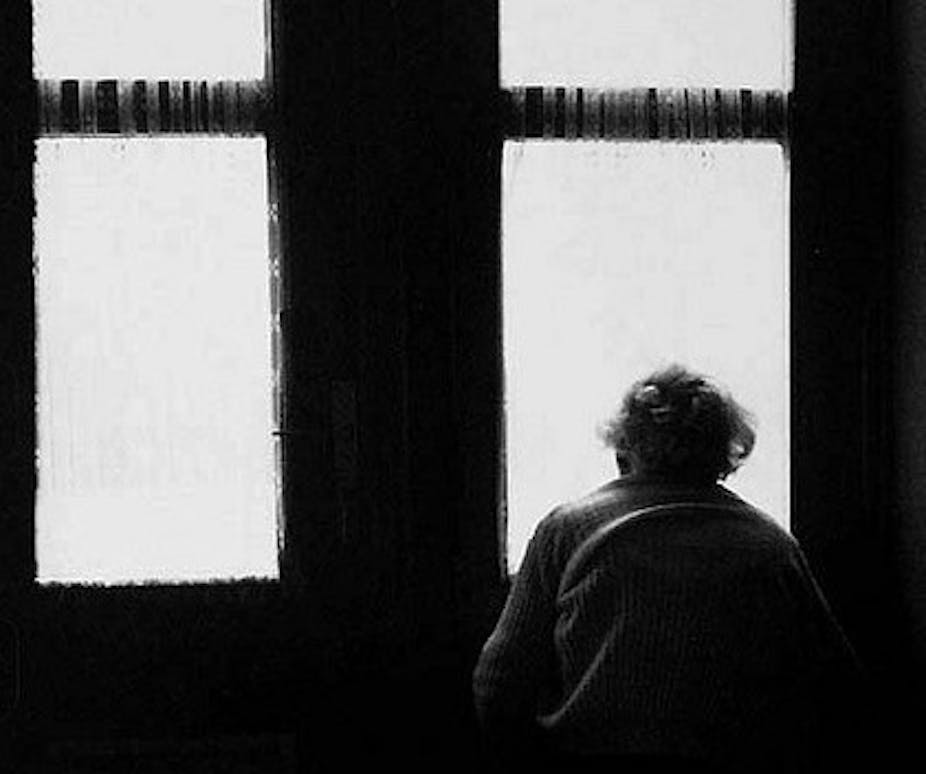Last night ABC’s Lateline discussed the case of 63-year-old John Burns, who died within 12 days of going into residential aged care. Burns was put into care after he started to display disinhibited sexual behaviour, and was prescribed anti-psychotics soon after.
The show reported that up to 60% of nursing home residents are on psychiatric drugs with as many as 30% on powerful anti-psychotics. It yet again draws attention to a problem that’s been recognised for over 20 years: the overuse of sedative medication in nursing homes.
And despite strong evidence that many of these drugs are not only often ineffective but may also cause substantial harm (in the worst case, strokes, pneumonia and death), their use appears to be increasing in Australia.
A case study
Lilian moved into the aged care home several weeks ago. She is 84 years old, recently widowed and, two years ago, she was diagnosed with Alzheimer’s disease. Lilian displays certain behaviours that are annoying other residents and some of the nursing staff. The main issue is that she goes into neighbouring rooms and sorts through cupboards, taking out other resident’s toiletries and underwear.
This is a real case that was described to me by nurses who were interviewed for a study looking at sedative medication use in aged care. To address Lilian’s behaviour, a nurse contacted her doctor to discuss the issue and they decided to give her a small dose of diazepam to see if it would help.
Diazepam, better known by its trade name of Valium®, is a long-acting benzodiazepine prescribed mainly for anxiety. There’s limited evidence that it’s effective for managing behaviours associated with dementia. So was it appropriate to prescribe this medication to manage Lilian’s behaviour, or is she being chemically restrained?
Chemical restraint

A variety of medications are prescribed in aged-care homes for their sedative properties. Some are used to manage the behavioural symptoms of dementia, and include anti-psychotics and benzodiazepines. And the use of these agents appears to be increasing. A recent study conducted in 44 Sydney aged-care homes found that over 28% of residents were taking anti-psychotic medications. The researchers noted that six years earlier, drug use in the same group was 24%.
So what exactly does the term “chemical restraint” mean? The definition used by the Federal Government is the “intentional use of medication to control a resident’s behaviour when no medically identified condition is being treated, where the treatment is not necessary for the condition or amounts to over-treatment of the condition.”
It may seem obvious to readers that, according to this definition, Lilian is being chemically restrained but many health practitioners working at aged-care homes wouldn’t agree. One director of nursing I interviewed said, “We don’t chemically restrain our residents….anyone that is prescribed a sedative medication has a medical condition; be it dementia, anxiety or a problem getting to sleep.”
Others feel that someone is only chemically restrained when the sedative dose is too high. This broad interpretation of what chemical restraint constitutes, or rather, does not constitute, validates the use of sedative medications for a substantial proportion of aged-care residents.
A growing problem
The prevalence of mental health conditions in the residential aged-care is increasing as the population ages and long-term psychiatric beds remain closed.
According to the latest Australian Institute of Health and Welfare (AIHW) report on aged care, over half of aged-care home residents have dementia. The majority of these residents will have symptoms such as aggressive behaviour, calling out and wandering. Over a third will have anxiety disorders and over half will have disturbed sleep. These statistics indicate that the majority of residents are likely to display mental health symptoms.
Among residents with serious mental illness, such as schizophrenia, major depression and severe aggression, the benefits of using sedatives outweigh harms. But for less serious mental health conditions, using such medication is not ideal.
Giving sedatives to older residents can result in significant harm, including confusion, falls, increased rates of pneumonia and even death, especially in the case of antipsychotics.

Many of these medications only have modest effectiveness in treating difficult behaviours, anxiety and sleep disturbance. And there’s a mounting body of evidence that non-drug strategies can be effective for treating these symptoms. At the very least, non-drug measures should be trialled before sedative medication is prescribed.
Better alternatives
Behavioural symptoms of dementia, anxiety and sleep problems are not always caused by the dementia itself, but can be caused by other underlying medical conditions, such as infections or pain. So it’s important to rule out such causes first before starting treatment. But according to nursing staff, there’s often inadequate assessment of residents.
Non-drug strategies that are effective in managing symptoms include relaxation therapy, personalised music, video tapes of family members, one-on-one time and providing basic counselling and sleep hygiene measures. But many aged-care homes don’t have the staff, training or resources to provide these strategies. As one relative told me, “I just wished that the staff had the time to just be with her and calm her, talk with her and settle her down.”
Excessive sedative use in aged-care homes is thought by many to be symptomatic of problems in funding adequate staffing, training and medical services in this sector. Little progress in reducing reliance on sedative use or chemical restraint can be made until this under-resourcing is addressed.

